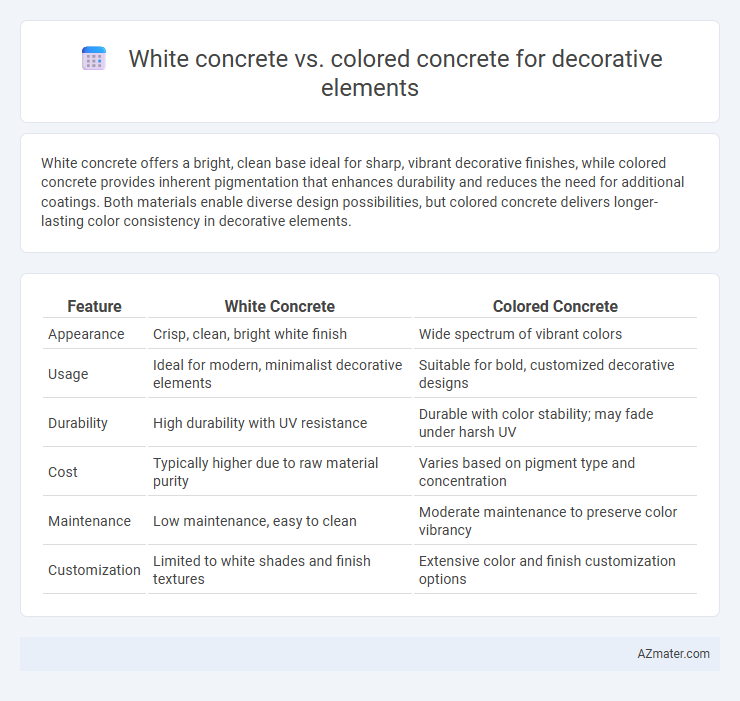White concrete offers a bright, clean base ideal for sharp, vibrant decorative finishes, while colored concrete provides inherent pigmentation that enhances durability and reduces the need for additional coatings. Both materials enable diverse design possibilities, but colored concrete delivers longer-lasting color consistency in decorative elements.
Table of Comparison
| Feature | White Concrete | Colored Concrete |
|---|---|---|
| Appearance | Crisp, clean, bright white finish | Wide spectrum of vibrant colors |
| Usage | Ideal for modern, minimalist decorative elements | Suitable for bold, customized decorative designs |
| Durability | High durability with UV resistance | Durable with color stability; may fade under harsh UV |
| Cost | Typically higher due to raw material purity | Varies based on pigment type and concentration |
| Maintenance | Low maintenance, easy to clean | Moderate maintenance to preserve color vibrancy |
| Customization | Limited to white shades and finish textures | Extensive color and finish customization options |
Introduction to Decorative Concrete
White concrete offers a bright, reflective base that enhances vibrant color pigments, making it ideal for decorative elements requiring a clean, striking appearance. Colored concrete integrates pigments directly into the mix, allowing for customized hues that maintain color consistency throughout the material, essential for artistic and architectural designs. Both options provide durable, versatile surfaces for decorative concrete applications, with white concrete better suited for high-contrast designs and colored concrete offering a broader color palette.
Overview of White Concrete
White concrete is a specialized building material known for its clean, bright appearance achieved through the use of white Portland cement and carefully selected aggregates. This type of concrete offers superior aesthetic appeal for decorative elements, allowing for vibrant staining and enhanced contrast compared to standard gray concrete. Its durability and versatility make it ideal for architectural features, facades, and artistic installations where visual impact is crucial.
Overview of Colored Concrete
Colored concrete offers versatile design options by integrating pigments directly into the concrete mix, allowing for consistent and long-lasting coloration in decorative elements. It enhances exterior and interior spaces with customizable hues ranging from subtle earth tones to vibrant shades, maintaining durability and UV resistance. This option minimizes the need for surface coatings, reducing maintenance while providing aesthetic flexibility in architectural and landscaping projects.
Aesthetic Options and Visual Appeal
White concrete offers a pristine, bright base that enhances the vibrancy of pigments, providing a clean, modern aesthetic ideal for minimalist and contemporary decorative elements. Colored concrete delivers diverse hues and custom color blends, allowing for greater creativity in visual appeal, ranging from bold, saturated tones to subtle earth shades that complement natural surroundings. Both materials lend versatility in texture and finish, but white concrete often accentuates light reflection, while colored concrete emphasizes depth and warmth in decorative applications.
Durability and Performance Comparison
White concrete offers superior reflectivity and UV resistance, making it less prone to discoloration and surface degradation over time compared to colored concrete. Colored concrete, while providing versatile aesthetic options through integral pigments, may experience slight fading or alteration under harsh environmental conditions, influencing its long-term vibrancy. Both types demonstrate high compressive strength and durability suitable for decorative elements, with maintenance and exposure factors primarily determining performance longevity.
Installation Techniques and Challenges
White concrete offers a smooth, uniform base ideal for intricate decorative elements, requiring precise curing to avoid discoloration and surface blemishes, while colored concrete demands meticulous pigment mixing and consistent batching to ensure color uniformity throughout the installation. Both materials require skilled workmanship to prevent common challenges such as cracking, efflorescence, and uneven texture; however, colored concrete installations often face heightened difficulties in matching shades and maintaining vibrancy under UV exposure. Proper substrate preparation, controlled environmental conditions, and advanced sealing techniques are critical in achieving durable, aesthetically pleasing decorative finishes for both white and colored concrete applications.
Cost Analysis: White vs Colored Concrete
White concrete typically incurs higher material costs due to the use of pure white cement and special aggregates, making it pricier compared to standard gray concrete used in colored variations. Colored concrete costs vary depending on pigment type and concentration, with mineral oxide pigments providing a cost-effective and durable coloring option. Maintenance expenses for white concrete may be higher because of its susceptibility to staining and discoloration, impacting the overall cost analysis when selecting between white and colored concrete for decorative elements.
Maintenance and Long-Term Care
White concrete offers superior reflectivity and tends to show stains and dirt more prominently, requiring regular cleaning to maintain its pristine appearance. Colored concrete incorporates pigments that can fade over time due to UV exposure, necessitating periodic sealing and touch-ups to preserve color vibrancy. Both types benefit from routine maintenance practices such as sealing, gentle washing, and prompt repair of surface damage to ensure long-term durability and aesthetic appeal in decorative applications.
Environmental Impact Considerations
White concrete typically requires more energy-intensive manufacturing processes and higher amounts of titanium dioxide for pigmentation, increasing its environmental footprint compared to colored concrete, which uses natural pigments or additives with lower ecological costs. Colored concrete reduces the need for additional surface treatments such as paints or stains, thereby decreasing volatile organic compound (VOC) emissions and maintenance-related waste over the lifespan of decorative elements. Selection between white and colored concrete should consider lifecycle analysis focusing on raw material extraction, energy consumption, and durability to optimize sustainability in decorative construction applications.
Choosing the Right Option for Your Project
White concrete offers a clean, bright base ideal for vibrant, high-contrast decorative elements, enhancing color intensity and creating modern aesthetics. Colored concrete integrates pigments directly into the mix, providing uniform hues and allowing for customized shades that complement the project's design scheme. Selecting between white and colored concrete depends on desired visual impact, durability requirements, and compatibility with other materials, ensuring the decorative element aligns with the overall architectural vision.

Infographic: White concrete vs Colored concrete for Decorative element
 azmater.com
azmater.com